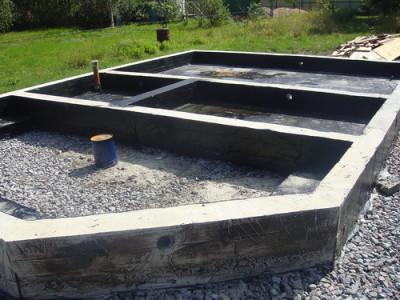The construction of the house always begins with the preparation and investment of the foundation. The foundation is the main supporting structure that perceives all the loads from the above-being structures and transmitting them to the base. It is he who is able to protect the walls from groundwater and soil oscillations. Therefore, the choice of the correct type of foundation and its specialized installation will allow your home to simultane a long amount of time.
Types of foundations:
- pile (installed where there is a high probability of flood);
- solid (suitable for those soil types, where water rises high enough);
- columnal (remarkably suitable for small light buildings);
- ribbon (used in low-rise construction).
Choosing materials for the construction of the foundation
Reinforced concrete and heavy concrete are considered the most popular building materials for the construction of the foundation. They provide the necessary strength of the base and are resistant to moisture. The main advantage of these materials is the possibility of creating a monolithic type of foundation, which will give the structure additional hardness. Concrete base is remarkably suitable for block and small brick buildings.
Some prefer special bricks. However, in its properties and cost, he loses concrete.
For small wooden structures, it is possible to make a foundation from a similar building material. At the same time, its main disadvantage is the minimum resistance to moisture and fungus. In the dry places in a certain way, the treated tree can be a wonderful basis for the future at home.
Soil is the basis of the foundation
Recommendations:
- if the soil is weak, and the load on it will happen quite high, it makes sense to install a pile foundation;
- if the soil allows, and you do not plan to create a large load - install a column foundation;
- if there is a oscillation of groundwater, then make a solid look of the foundation;
- if the ground does not float, and you build a brick house, then consider the belt basement version.
There are cases when, applying some tricks of construction, several types of foundations are established. However, for this you need to seek help from specialists.
And remember: it is better to overpaid a little and make the foundation better than it later to break your head from the fact that the crack crawled along the wall.
Depth of the Boundage of Foundation
Most often, the foundation is laid slightly lower than the depth of the soil freezing - this is done in order to prevent their release. The foundation is calculated on the basis of:
- climate features of this region;
- depth of underground communications;
- the nature of the load values;
- features of the corning;
- depending on the properties of underlook soils, etc.
At the same time, the depth of the embedding should be sufficient to ensure the sustainability of the base and eliminate the likelihood of the soil.
In non-empty soils, at the location of groundwater at a high distance, it is allowed to lay the fundamental sole above the depth of the soil freezing. However, for this, specialists should correctly calculate the average pressure on the basis and design features of the building.
Foundations of buildings that are equipped with basement rooms, with an increased yield, should have a special waterproofing that can exclude the possibility of their flooding. Also used with defined additives dense concrete, inlet, coating and other types of waterproofing.
Foundation base device
Most often before starting construction work, the contractor already has a design of the structure, in which there are foundation calculations with reference to the type of soil, terrain, etc.
The base under the foundation (pillow) is part of the ground massif on which the foundation itself is located. The durability and strength of the foundation depends on the quality of this pillow, as well as the exposure to its shrinkage.
Today, during the construction of houses, many developers apply a concrete belt foundation. At the same time, the basis for which it should be laid may be several species:
- bay concrete pillow;
- funny crushed stone pillow.
Thus, choosing the type of foundation base, must be taken into account the prescriptions and design calculations, which indicates the depth of the cushion device.
How to prepare the foundation under the foundation
The purpose of preparing the foundation under the foundation is:
- providing on a certain mark of contact of the base with the surface of the basement of the foundation;
- creating the bearing capacity of the ground ground.
Preparation process:
1. Cleaning the bottom of the trench (pit)
This action is performed throughout the area of \u200b\u200brecovery with the help of a bulldozer, which the excavator is cut off by an unfinished soil. Peers are fixed on the intersection of the corners and axes of the walls. Their top is determined by the level of level. The soil, the setpoint of the knife, is cut off manually when the cleaner.
By producing mechanized cleaning of the pit, it is necessary to cut the soil just below the design mark, and the pegs are plugged to the top of the sand.
2. Tamping base
The sealing of the soil surface in the pit is created with cam or smooth heavy rollers. You can also use jumping diesel and pneumatic traamies.


Tamping takes place with certain sequential blows. They are distributed evenly on the surface of the transverse strip of terrain.
Recommendations for soil sealing:
- chip and sandy rocks are compacted by vibration;
- forest subsidence are sealing with soaking, pouring pre-drilled water wells filled with drainage materials;
- the deep seal of the soil occurs with the help of hydrovipment, which simultaneously moisturizes the soil until complete saturation;
- sculated and clay weak soils are sealing soil or sandy pile;
- peat soils that climb earth embankments, stabilize with the help of electric space and vacuuming.
3. Drainage (moisturizing) of the soil during its seal (if necessary).
Rubbed base under the foundation
In fact, the technological process of bookmarking the cushion pillows is quite simple. The main thing is to achieve compliance of the top layer of the material the level of the bottom mark. In this case, the width of the base should be slightly larger than the width of the foundation at 0.15-0.20 m around the perimeter.
The device of a rubber base under the foundations:
- initially, the sandy layer with a thickness of 0.05-0.10 m;
- then it is poured with water;
- next lasted a layer of rubble 20-25 cm;
- during the tamper, crushed stone should be plugged to go to the desired level.
Sand base under the foundation
The device of a sand pillow under the basement sole:
- first you need to dug a trench (pit);
- next, thoroughly smalle it.
- then we fall asleep the trench (pitched) layers of sand 20 cm, moderately moisturizing it and the rampant (the sand should be so good to ravage so that there are no traces from the boot on the surface);
- tamping and frustration occurs until the desired thickness is obtained (the surface layer should be as smooth as possible by horizontally);
- upon completion of the activity, you can proceed to reinforcement and installation of formwork.
Advantages of using sand pillows:
- such a pillow can resist compression and is an intermediate link between the soil and the foundation;
- this type of material can be replaced by problematic soil;
- it allows you to align the bottom of the pit (trenches);
- due to the use of sand, the soil becomes stronger, which reduces the precipitate of the structure;
- pillow protects reinforced concrete from moisture effects.
Recommendations:
- it is best to use gravel a large formation of sand or river pure sand of the middle fraction;
- the maximum thickness of the sandy pillow for a ribbon type of foundation must be multiple three times its width;
- to extend the life of a sandy pillow and protect it from pouring with an increased cov, to put geotextiles in the pit (trench) before it;
- it is best to lay a trapezoidal pillow of sand, which narrows down at an angle of 30 °.
How to prepare the foundation for the foundation of the video:




























